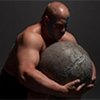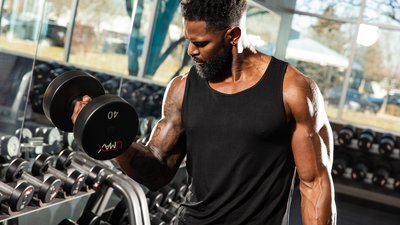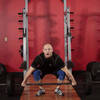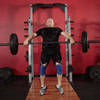When people want "to feel your muscle," they invariably mean your biceps, even though the upper arms constitute just a small percentage of overall muscle mass. Heck, arms aren't nearly as important to athletic movement as the legs. Yet people are still obsessed with arms, to the point that they often (foolishly) train them more than bigger body parts.
Many assume this trend came from "Pumping Iron" and the Golden Age of modern bodybuilding, but the "Father of Modern Weightlifting," Bob Hoffman, divined this obsession before bodybuilding was even a competitive sport. He saw that big arms make a man feel more comfortable, attractive, and even powerful. So in 1939 he published The Book of Big Arms (1939) in an attempt to address this phen-ARM-enon.
I can hear you now: 1939 was a long freakin' time ago, and I've never even heard of this Bob Hoffman dude. Well, if you haven't heard of Bob, it's because Joe Weider beat him in the battle of iron-game pioneers, and winners write history, especially when they are publishers.
Pull up your weight bench for a little history lesson, son: Before Arnold was a twinkle in his father's eye, Bob was building an empire of Olympic weightlifters, fighting the commies, and (literally) forging iron to train his lifters. He was making muscle men before cables, machines and even power racks were invented.
Like Weider, Hoffman published fitness magazines, but Weider's mags were more commercially successful. Was his information better than Hoffman's? Not necessarily. You can make the argument that Hoffman's method of arm training was superior to the Master Blaster's.
That is exactly the argument I make here. To prove my point, I'm going to dust off a copy of Hoffman's arm training book and present his arm-building regimen. And your results from following this book's workout advice will speak volumes for years to come.
Arm Yourself
How did Bob choose to arm the general population? According to him, many fail to build their arms precisely because they perform too many arm exercises.
Like Bob, I think if you focus heavily on basic movements, the secondary training effect on your arms will force them to grow. Ever heard of collateral damage? Well, consider this collateral improvement. And it is way more effective than repping curl after curl …
Pull-ups, heavy pressing, and picking up 400-pound rocks can go a long way to stimulating arm development. Why? If your arms don't grow under such heavy loads, they'll rip the eff off. Training the arms as part of a system results in complete development and useful strength; it also earns you big-bear hands and bowling-pin forearms. A small amount of extra hypertrophy specialization is all that's necessary to make your arms pop.
How you approach your arm specialization depends upon the type of program you are doing. Hoffman recommended full-body programs; his focus was on health and Olympic-style weightlifting, with variations in intensity over the week.
I can't argue with this style of training, and his programs are much underrated in my opinion (try one course; it will leave you crushed), losing popularity to body-part splits popularized by Arnold and the Golden Age gang.
Arms by the Book
Hoffman suggested that lifters use four different schedules (credit to Dan John for the training summary below):
- Course No. 1, consisting of one set each of 10 standard barbell exercises, performed for one set of 10-15 reps.
- Course No. 2, consisting of a similar course, but using different exercises. For example, press behind neck instead of standing press.
- Course No. 3, consisting of 10 movements, performed for one set of 5-10 reps each.
- Course No. 4, consisting of a heavy day where you worked up to your max on the Olympic lifts (including the clean and press and the 1-hand snatch), along with the bent press.
The lifter might cycle through these during the week (always with a day of rest in between), doing one heavy day, one light day, and one or two moderately-heavy days. Where does the arm specialization come in? On days when you have more energy after completing primary work, add a couple of arm movements.
Feeling fatigued? Feel free to skip extra arm work. This same philosophy is what you will see in high school and college weight rooms across America.
Tacking on a little extra arm work to the end of your training if you have the energy is fine; just don't let it take precedence over the big stuff.
Arms-by-the-Book Workout

BodyFit
$6.99/month- 2,500+ expert-created single workouts
- 3,500+ how-to exercise videos
- Detailed workout instruction
- Step-by-step workout tips
- Training at gym or at home
- Access to Workout Plans
- Access to Bodyfit App
- Store Discounts
Already have a Bodybuilding.com account with BodyFit? Sign In

What comes with BodyFit?

- Instructional Videos
Don't risk doing a workout improperly! Avoid injury and keep your form in check with in-depth instructional videos.

- How-to Images
View our enormous library of workout photos and see exactly how each exercise should be done before you give it a shot.

- Step-by-Step Instructions
Quickly read through our step-by-step directions to ensure you're doing each workout correctly the first time, every time.
Bonus Feature: 4 Arm Exercises You Have Never Even Heard Of!
In earlier training days, guys had to create their own exercises, since most exercises we have now had not yet been invented.
For lifters who don't have pythons big enough to attract attention at the gym, here are some movements that are sure to garner some looks.




